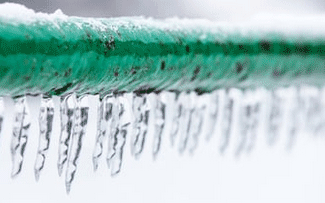by Tony Greer
(Cresco, IA)
I work in an automated feedmill and the air compressor that opens and closes my scale gates is located in a warehouse about 60 feet away from my mixing room.
When the weather gets cold i have a problem with the vapor in the lines freezing and not allowing the solenoids to function properly which in turn won’t allow the gates to open/close.
Is there a way to use an air tool oiler or something to bleed airline antifreeze into the lines periodically?
_____________________________

Hello Tony:
I suppose you could put an air line lubricator in the line to add anti-freeze, but I don’t recommend it as a solution, as lube oil, too, will thicken and eventually freeze.
I don’t know what the anti-freeze would do to seals and so on, and then you would have anti-freeze fogging out the valve’s exhaust port, too, so I don’t think that’s an option, though I know that some folks have done so.
I think what you need to do is install a desiccant dryer at the point before the lines go outside. A desiccant dryer will remove all water vapor until the air has a DEW point well below the coldest point through which the compressed air has to travel in the lines. The air will be pretty much bone dry. Then there is no water vapor in the compressed air line to condense and freeze.
There’s a page about desiccant dryers on this site. There will be cost involved. You are the one to weigh the cost of fixing the air properly to resolve the problem against the PITA effect and lost production through frozen air lines to determine the course of action that is most worthwhile for you and your firm.
Let us know how it turns out, K?
Another post about… Compressor freezing lines up
by noel brady
(cavan Ireland Europe)
We are having problems with our compressed air freezing in our tools for pumping insulation.
We have a 106cfm at 7 bar compressor running in a truck body, the air temp is 3 degrees and the hose length is 40m.
At the end is a PCL coupling which is freezing.We have two inline filters which remove the moisture apparently.
Is there something else we can do, warm the air? Add antifreeze in the oiler?The equipment is using 2 x 40 cfm. We have to keep dipping the tools into warm water to unfreeze them.
___________________________________
Noel, the lines are freezing as you are pumping hot, moist, water vapor-laden compressed air into lines that are running through cold temps.
The water vapour in the lines is condensing, and freezing. You need to strip the water vapour out of the air, not just the free water, from the compressed air stream before it gets to the cold lines.
How much money do you want to spend on desiccant air dryers?
Post about Plumbing compressed air outside
by Dave
(USA)
I need to pipe compressed air from one building, outside and into another building.
Temperatures can get down to minus 35 below zero in the winter months here.
Would placing an insulated pipe inside of an insulated box with air from the two buildings allowed to circulate in the box between the buildings be enough to not give me any problems with moisture?
The distance between the two buildings is 20 ft.
Thank you.
Dave
______________
Hi Dave:
The problem of water in your pipe between buildings is that it will freeze in the winter time, and, depending on how much water your compressor generates, there’s a real possibility of ice closing the inside of the pipe entirely.
Picture a cold beer on the railing of your deck. It’s mighty hot outside, and it doesn’t take long before beads of water form and start dripping down the outside of the bottle as water vapor in the air condenses on the cold surface of the beer bottle.
The cold beer inside your bottle is equivalent to the cold air that will be on the outside of your compressed air pipe running between the buildings.
The compressed air inside your pipe is warmer than the outside of the pipe passing through minus degree temperatures, and so condensation takes place inside your compressed air pipe as does on the outside of your ice cold beer bottle in the summer time.
If you have moisture in your compressed air (whether free water or water vapor)and that compressed air gets exposed to a surface that’s colder than the air itself, then condensation takes place.
In order for compressed air to flow in a pipe outside in sub-zero temps, and not have water condensing out inside the pipe, either the compressed air has to be colder than the temperature outside the pipe or the compressed air has to be dried to a dew point below the temperature of the inside surface of the pipe through which it flows.
With the steps you are taking to insulate the pipe, you must make certain that the pipe temperature stays above the temperature of the compressed air passing through it, and you want to have that compressed air passed through an air-dryer before it exits the building.
